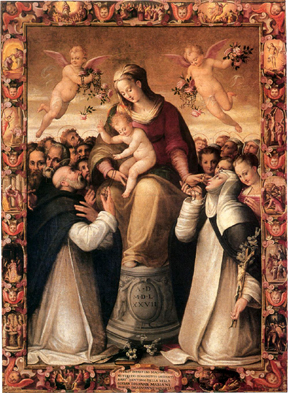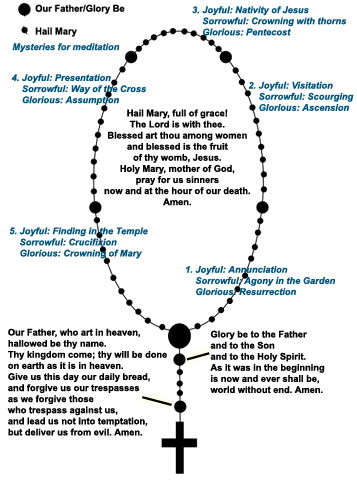October 7
Our Lady of the Rosary, Roman Catholic Church
Pope Pius V instituted the
feast of Our Lady of the Rosary to commemorate the naval battle of
Lepanto in Greece, where on October 7, 1571 a Christian coalition fleet
defeated the Turkish armada. Pope Pius's leadership, financing, and
alliances made the historic victory possible—along with, in Catholic
tradition, the intercession of Our Lady through the prayers of the Rosary
Confraternity throughout the campaign. During the battle, Pius V led
prayers before her holy icon in Santa Maria Maggiore.
How to say the Rosary:
|
 An altarpiece of 1577 (above) recalls the tradition, started by Blessed Alan de Rupe in 1460, that the Rosary originated when the Virgin herself gave it to St. Dominic de Guzman in 1208 or 1214. The Madonna shows a rosary to St. Dominic kneeling at her right, while blessing St. Catherine of Siena's rosary on her left. Workshop of Michele Tosini, Madonna del Rosario, Santuario di Santa Liberata, Cerreto Guidi, Fiesole, Firenze, Tuscany, Italy (from www.santaliberata.org). |
|
The Ave Maria (Hail Mary) prayer combines the greeting of the Angel Gabriel, "Hail, Mary, full of grace, the Lord is with thee" and that of St. Elizabeth, "Blessed art thou among women, and blessed is the fruit of thy womb" (Luke 1:28 & 42) with an ending added during the 1500s, "Holy Mary, Mother of God, pray for us sinners now and at the hour of our death." In early rosary devotions, the Biblical salutations concluded with a simple Amen, or with other short prayers or reflections.
Prayers have been added to the rosary as well. By the 1500s, a crucifix often hung from the circle on a string of an additional Pater Noster and three Ave beads. In the 1600s, it became common to say a Gloria after each decade, before the Our Father. This is now universal. In many places (such as the U.S.) it is also customary to precede the rosary with the Apostles Creed (Credo) and to conclude it with the Hail Holy Queen (Salve Regina). Often a prayer that Our Lady of the Rosary requested at Fatima (1917) is added between the Glory Be and Our Father: "O my Jesus, forgive us our sins, save us from the fire of hell, and raise all souls to heaven, especially those who most need your mercy." Pope John Paul II added a fourth sequence of "Luminous Mysteries" with meditations on Christ's active mission: his baptism; the miracle at Cana; the message of God's Kingdom; the Transfiguration; and the Last Supper.
Many Catholic churches hold Rosary devotions before or after masses, and the Rosary is often recited at private services for the dead.
Sources include:
| "The Rosary prayer and the Carthusians," www.geocities.com/hashanayobel/homilies/pensieri/Rosary2.htm | |
| "Catholic Encyclopedia: The Rosary," www.newadvent.org/cathen/13184b.htm; en.wikipedia.org/wiki/Rosary | |
| John D. Miller, Beads and Prayers, Continuum International Publishing Group, 2002 | |
| Michael P. Carroll, Catholic Cults and Devotions, McGill-Queen's Press, 1989 | |
| Guillermo Romero, commons.wikimedia.org/wiki/Image:Rosary.svg, textless rosary image |
Also commemorated this date:
| Nuestra Señora de la Pobreza, Pereira, Risaralda, Colombia (Our Lady of Poverty) | |
| Notre-Dame de Victoire, Lorient, Morbihan, Brittany, France. English siege ended, 1746; remembered 1st Sunday of October. | |
| Notre-Dame de Vigilance, Pouligney, Doubs, Franche-Comté, France. Statue erected, 1860. | |
| Notre-Dame-de-la-Victoire, Thuir, Pyrénées-Orientales, Languedoc-Roussillon, France | |
| Maria-Schnee, Bütthard, Lower Franconia, Bavaria, Germany (Mary of the Snows). Procession on Feasts of the Rosary & Ascension. | |
| Virgen del Carmen de la Legua, Callao, Callao, Peru. Statue crowned, 1951. Fiesta July 16. | |
| Matka Boza Laskawa, Warsaw, Poland (Gracious Mother of God). Patron of Warsaw. Painting crowned, 1973. | |
| Mirozh Mother of God, Pskov, Russia (24 September old calendar) | |
| Mare de Déu del Remei, Petrer, Alicante, Valencia, Spain. Statue found hidden in church wall at request of visiting friar, 1630; fiesta. | |
| Our Lady of Peace, Santa Clara, California, USA. Shrine dedicated, 1983. |
